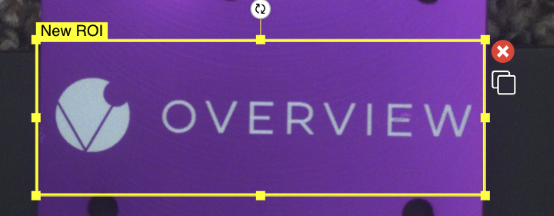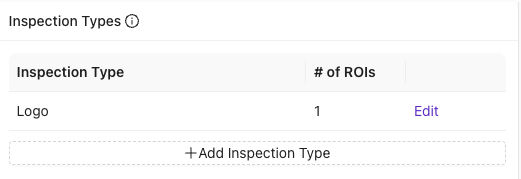Inspection Setup & ROI Types
This page explains the fundamental concepts behind defining inspection areas and organizing AI-based inspection workflows in the OV20i system.
ROI (Region of Interest) Fundamentals
What are ROIs?
ROIs (Regions of Interest) define rectangular areas where the AI model will perform inspection analysis. These regions focus processing power on specific locations, improving both accuracy and efficiency.
Core ROI Concept:
- AI Model Workspace - ROIs serve as the reference positions where AI models analyze image data
- Processing Efficiency - Focused analysis improves inspection speed
- Result Precision - Targeted analysis reduces false positives
- Multiple Regions - Multiple ROIs can be defined for comprehensive inspection

ROI Types in OV20i
Rectangular ROI Only
The OV20i uses rectangular ROIs as the single ROI type for all inspection scenarios.
Why Rectangular:
- Universal Application - Suitable for most industrial inspection needs
- AI Optimized - Rectangular regions optimize model processing
- Simple Implementation - Straightforward setup and management
- Alignment Compatible - Works seamlessly with template alignment system
ROI Naming and Identification
Default Naming: "New ROI"
Each new ROI starts with the default name "New ROI" which can and should be changed to provide meaningful identification.
Why Change ROI Names:
- System Integration - Named ROIs are easier to reference in automation
- Maintenance - Clear names simplify troubleshooting
- Documentation - Meaningful names improve system understanding
Naming Examples:
- "Bolt_Tightness_Check"
- "Label_Presence_Verify"
- "Surface_Quality_ROI"
- "Component_Alignment"
Inspection Types: Grouping and Organization
Default: "Inspection Type 1"
The system creates "Inspection Type 1" as the default grouping name, which should be changed to reflect the actual inspection purpose.
Inspection Type Function:
- ROI Grouping - Organizes related ROIs under logical categories
- Result Organization - Groups inspection outcomes by type
- Workflow Management - Simplifies complex multi-area inspections

Critical: Node-RED Integration
Why Inspection Type Names Matter: It is important to change the Inspection Type name because Node-RED uses this name for output publication. The name becomes the identifier for data routing and system integration.
Node-RED Output Impact:
- Data Publishing - Results are published using Inspection Type names
- External Integration - Other systems receive data with these identifiers
- Automation Logic - Node-RED flows reference these names for routing
Effective Naming Strategy:
- Process-Based: "Quality_Control", "Dimensional_Check"
- Feature-Based: "Surface_Inspection", "Component_Verification"
- Location-Based: "Top_Panel_Check", "Side_Assembly"
- Avoid Generic: Replace "Inspection Type 1" with specific identifiers
Setup Workflow
Configuration Process
Essential Steps:
- Inspection Type Naming - Change from "Inspection Type 1" to meaningful name
- ROI Creation - Add rectangular regions using + Add Inspection Region
- ROI Naming - Change from "New ROI" to descriptive names
- Positioning - Size and position ROIs appropriately
- Validation - Verify setup meets inspection requirements
Multiple ROI Management
Organization Strategy:
- Logical Grouping - Group related ROIs under appropriate Inspection Types
- Consistent Naming - Use systematic naming conventions
- System Integration - Consider Node-RED output requirements
Integration Considerations
Template Alignment Integration
Alignment Benefits:
- Automatic Adjustment - ROIs move with part alignment corrections
- Consistent Coverage - ROIs maintain relative position to part features
- Position Tolerance - Part variations don't affect inspection accuracy
Node-RED Compatibility
Integration Requirements:
- Unique Names - Ensure Inspection Type names are unique for outputs
- Naming Standards - Establish conventions for system integration
- Output Testing - Verify Node-RED receives correct identifiers
Best Practices
Effective ROI Configuration
Key Guidelines:
- Descriptive Naming - Both ROI and Inspection Type names should be meaningful
- Appropriate Sizing - Balance feature coverage with processing efficiency
- Strategic Organization - Group related ROIs logically
System Integration
Planning Considerations:
- Node-RED Requirements - Plan Inspection Type names for data routing
- Documentation - Record ROI purposes and integration points
- Testing - Validate that outputs reach intended systems correctly